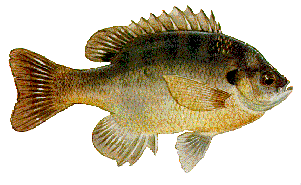Bluegill (Lepomis macrochirus)
- Other Names
- Bream, Brim, Perch, Sunfish, Sunperch
- Description
- Lepomis, the generic name, is Greek and means "scaled gill cover". The species epithet macrochirus is also Greek and means "large hand" which may refer to the body shape or its size. Bluegills may be distinguished from other sunfish by the dark spot at the base of the dorsal fin, vertical bars on their sides, and a relatively small mouth. The spiny dorsal fin usually has 10 spines (but may have as many as 11 or as few as 9), and is broadly connected to the soft dorsal. The anal fin has three spines. The back and upper sides are usually dark olive green blending to lavender, brown, copper, or orange on the sides, and reddish-orange or yellow on the belly. Colors are more intense in breeding males, and vertical bars may take on a reddish hue.
- Life History
- Bluegills begin spawning when water temperatures reach about 70°F. Spawning may peak in May or June, but continues until water temperatures cool in the fall. Because of their long spawning season, bluegills have very high reproductive potential, which often results in overpopulation in the face of low predation or low fishing pressure. Nests are created in shallow water, one to two feet in depth. Gravel substrate is preferred. Fifty or more nests may be crowded into a small area, thus creating a spawning bed. Males guard the nest until the eggs hatch and fry leave. Young fish feed on plankton, but as they grow the diet shifts to aquatic insects and their larvae. Up to 50% of their diet may consist of midge larvae.
- Distribution
- Bluegills appear to have been native to the eastern half of the United States, southeastern Canada and northeastern Mexico, exclusive of the coastal plain north of Virginia. Today, as a result of countless intentional as well as no doubt unintentional introductions, bluegill are found throughout the US and northern Mexico. Bluegills are found throughout Texas. Three subspecies are present: Lepomis macrochirus macrochirus which is native to the northeastern half of the state, Lepomis macrochirus speciosus which is native to the central, southern, and western portions of the state, and Lepomis macrochirus purpurescens, a native of Atlantic coast states which has been introduced widely as a sport and forage fish.
- Other
- Although less than one percent of licensed Texas anglers say they "prefer" to catch sunfish, bluegill and other sunfish are nevertheless a vital part of many freshwater fisheries nationwide, including Texas. Many pre-license age anglers begin their fishing careers by bank fishing for bluegills and other sunfish. Bluegills provide plenty of fight, pound for pound. In Texas, bluegills approaching two pounds have been landed in public waters, and fish over three pounds are known from private tanks. The largest bluegill on record was 4 pounds 12 ounces, landed in 1950 from Ketona Lake in Alabama.
